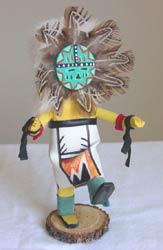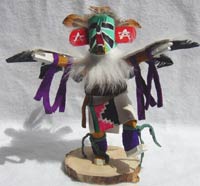
In the vast realm of Indian arts and crafts kachina figures provide classic, beautiful illustrations of the culture and history of the Hopi. While often referred to as “kachina dolls,” they are actually religious articles, carved and painted with reverence by Hopi whose gift it is to create them for ceremony.
The kachina images reflect the kachinas of belief – supernatural beings that live among the San Francisco Peaks in northeastern Arizona, near Flagstaff. While most are benevolent, some are not. Every December through July, as part of their annual cycle of ceremonies, Hopi men adopt the mask and dress of a particular kachina and are believed to be inhabited by the kachina they reflect.
The original small, carved versions of kachinas (also called “katsinas”) were created to educate Hopi children to the different kachinas and their religious role. The carvings also are kept in the home on shelves or hung from the ceiling to serve as reminders of the spirits that surround and infuse all aspects of life. While kachina figures will serve these purposes for the Hopi forever, in the last century they have also become of interest to art collectors and tourists. Realizing the demand, other tribes in the Southwest also have begun to create kachina images for sale.
The kachina world is fascinating, with more than 200 different spirits documented. With so many to create, most kachina carvers “specialize,” choosing just a few to create over and over. Most have specific, highly recognizable characteristics such as costume or animal identity. But some carvers “mix and match,” creating different characters of blended identity.
 Much has been written about the meaning of kachina and further research will open a wide world of belief and mystery to those who choose to look further and do research.
Much has been written about the meaning of kachina and further research will open a wide world of belief and mystery to those who choose to look further and do research.
The best place to make a kachina purchase is directly from the Hopi on the their reservation in Arizona. But the figures are available in arts and crafts shops and trading posts throughout the Southwest and across the country now. If you would just like to have one for decorative purposes or as a remembrance of a trip, many fine kachinas are now made by Navajo artists and non-Indians alike. If you plan to purchase a kachina as a serious investment or heirloom, you may want to guarantee you get one that is Hopi made, or Zuni, as that culture also is steeped in kachina belief and carving history.





